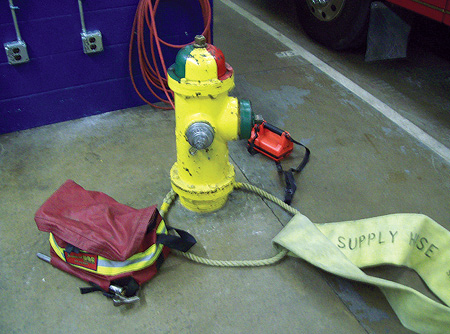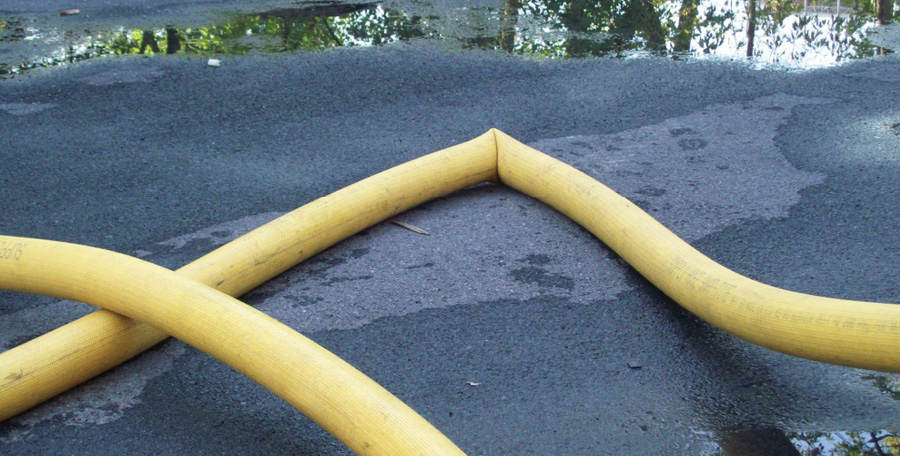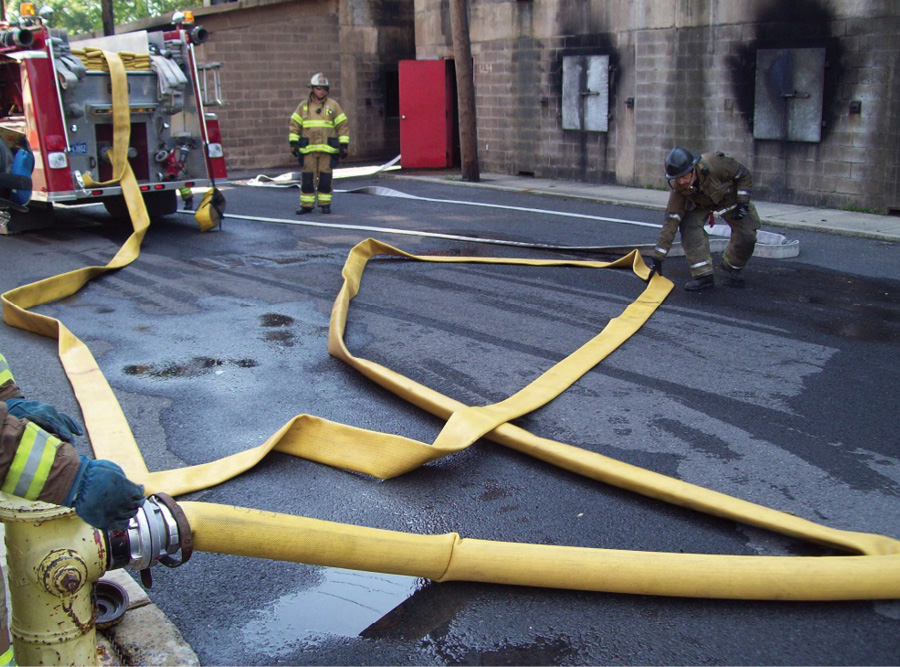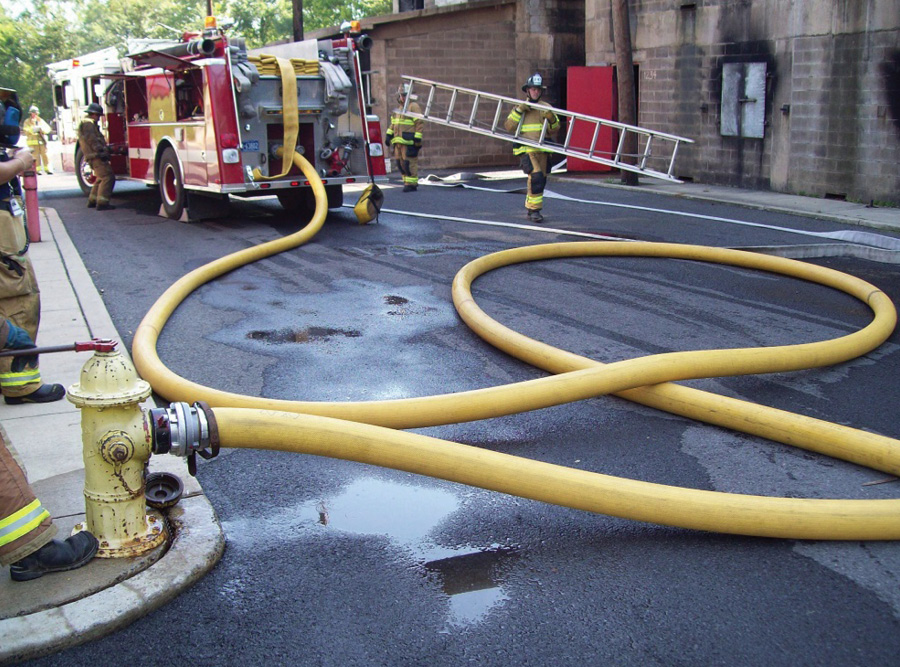By MARK VAN DER FEYST
In the world of firefighting, one of the basic tasks on which we instruct our new recruits is how to secure or establish a water supply. We often refer to this task as “hitting the hydrant” or “taking the plug.” Even though this is a basic task, we often overlook the importance in executing it effectively.

(1) Photos by author.
We have all seen pictures of hydrants with their supply lines going through car windows and underneath vehicles, twisted and full of kinks. At one fire to which I was dispatched, the first-due engine established the water supply but somehow managed to kink the supply line underneath the engine, keeping the water supply from reaching the engine.
We do not often hit the hydrant as frequently as we should because of the low number of fires that we are now attending. This, in turn, allows us to become rusty at this simple task.
Today, hydrants are usually found in urban areas, but we can find them in rural areas as well. In rural areas, where perhaps a major industrial plant is located, hydrants will have their own private hydrant system. I know of a few rural towns that relied on rural water operations for a water supply, but they also had two or three hydrants within the town. Usually, this back-to-basics function will apply to a select few areas, but the principle of removing kinks from supply lines is the same.
Apparatus Placement
When we hit the hydrant, the first step we take is to stop the truck at the hydrant, allow a firefighter to get off and secure a good section of supply line (either four or five inches) with hand tools. Once the firefighter has the needed supplies, he will wrap the supply line around the hydrant. He does this so that when the fire truck drives away to the fire (forward lay), it will not drag away the supply line and, subsequently, the supply line from the back of the truck will be deployed at the length of the forward lay.
At times, we instruct students that we need to kneel on or stand with one foot on the supply line so that the hose will not “take off” on us. One good method is called the “rope method.” In photo 1, a rope that is in a continuous loop is wrapped around a section of hose and a bag of tools. This method allows the firefighter to grab at once each item that he needs with just a pull of the rope. Our bag of tools should include items such as a spanner wrench, a hydrant wrench, a gate valve, a flashlight, a radio, and hose adaptors like storz to thread.
Once the firefighter has the rope in his hand, he can now pull off the required amount of supply line to hit the hydrant. In photo 2, the rope also acts as a method of securing the supply line to the hydrant so that the fire truck can drive away. This allows the firefighter to save time by not having to wrap the supply line around the hydrant and then kneel or stand on it; he can immediately begin work to establish the water supply.

(2)
Tools
When establishing a water supply, many times we are not in ideal conditions such as during bad weather or in weak lighting. Often, we lose or misplace our tools when we are opening up the hydrant because we drop them in tall grass around the hydrant or we are standing in mud or deep snow. It is good practice to always place your tools, hydrant caps, and flashlights at the base of the hydrant. This way, if the darkness or tall grass keeps you from seeing where you left the hydrant cap, you can simply feel down to the base of the hydrant and find it.
Another good practice is to place your hydrant wrench on top of the hydrant. Many times, we throw our tools on the ground in a rush to establish a water supply, and we lose them. By placing the hydrant wrench on top of the hydrant, it will always be there when you need it.
When hooking up a supply line to the hydrant, we sometimes neglect to use gate valves, which are great assets for the hydrant. They allow you to add or shut down additional supply lines (if needed) without having to shut down the hydrant. Also, if a hydrant stem breaks, you can disconnect the supply line and use the gate valve to shut off the hydrant. Often, we miss using a gate valve on the main supply line for the four- or five-inch steamer port; when the hydrant stem breaks, we are stuck because we need to leave our supply line attached to the hydrant as well as the pump panel to shut down the hydrant. Until maintenance crews arrive on scene to fix the problem, you now have a dedicated “gate valve,” which is now your apparatus.
It is also important to flush out the hydrant before connecting your supply lines. By doing so, you are checking to see if the hydrant is working and if there is any debris inside that may block or clog your supply line. This check does not take long, but we often forget it to do it.
Kinks
One of the major hoseline problems we face is kinks. We often see this with smaller handlines, but the problem also exists with supply lines. Photo 3 shows one such kink in a supply line. This one kink alone will reduce the amount of water pressure and supply by as much as 50 percent. Now, add in two or three more kinks, and you will quickly see how we sometimes compromise our water supply.

(3)
Kinks are formed because of irregular bends in the hose. With larger lines such as four-, five-, or six-inch supply lines, you must ensure that you have large, smooth curves or bends in the line. One way of accomplishing this is by using the “S” or figure eight method. Photo 4 shows a firefighter flaking out the supply line in a figure eight shape, which will allow the hose to become fully charged and ensure large, smooth bends in the line.

(4)
Photo 5 shows the end result. This method works well in short distances between the hydrant and apparatus. When you pull a 100-foot section of supply line off the hosebed and you only have to travel 40 feet, this method will ensure that no kinks will form. Often, we try to flake out the hose in a “Z” pattern, but this will only exacerbate the kink problem.

(5)
Removing a kink in a large-diameter supply line is no easy task. If you try to remove and straighten out a kink in, for instance, a five- or six-inch supply line by pulling it with your hands and back, you will most likely hurt yourself. If you must remove a kink from a large-diameter supply line, wrap a piece of webbing around the line and have another member help you pull the supply line straight. Of course, the best way to remove kinks is not to have any at all; accomplish this by using the “S” or figure eight method.
The basic task of securing a water supply through a hydrant may seem simplistic, but it is often not practiced enough. By going back to basics, we will ensure that the fire to which we respond will go smoothly from the start by establishing a water supply with no kinks.
MARK VAN DER FEYST is a 19-year fire service veteran and a firefighter in Ontario, Canada. He is an international instructor in Canada, the United States, and India and at FDIC International. Van der Feyst is a local level suppression instructor for the Pennsylvania State Fire Academy and an instructor for the Justice Institute of British Columbia. He is also the lead author of Residential Fire Rescue (Fire Engineering).

